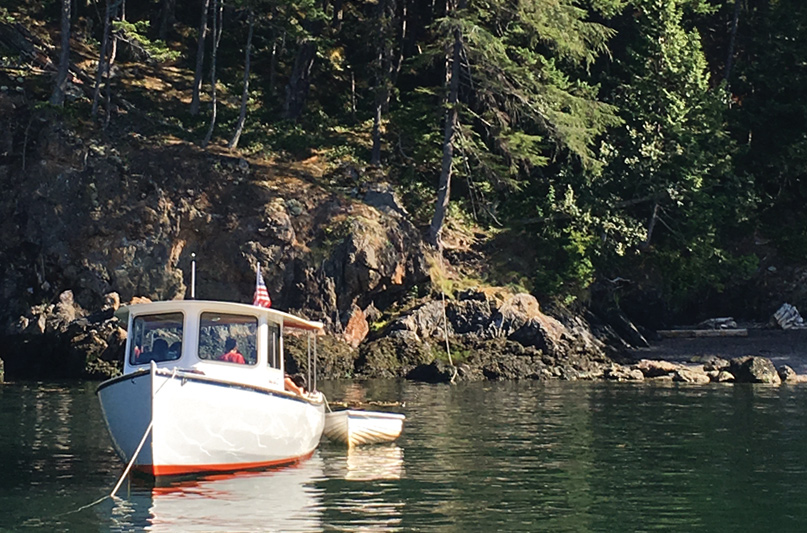 Alex Borton and his family completed an eight-day tour of the San Juan Islands aboard the Sam Devlin-designed Solar Sal 27, finishing the trip this summer without using any traditional fuel or plugging into shore power. The journey took the unique, solar-powered boat into the quintessential Northwest waters to see if her passengers could cruise in comfort for an extended trip.
Alex Borton and his family completed an eight-day tour of the San Juan Islands aboard the Sam Devlin-designed Solar Sal 27, finishing the trip this summer without using any traditional fuel or plugging into shore power. The journey took the unique, solar-powered boat into the quintessential Northwest waters to see if her passengers could cruise in comfort for an extended trip.
“We typically made a good 5 knots, running her 4-kilowatt motor at half throttle, drawing 1,000 watts from the batteries and getting 1,000 watts directly from the solar panels,” said Borton in his captain’s log of the voyage. The 27-foot boat hosted six people for the week, including two teens and two pre-teens.
Uninterrupted Cruising
The idea of cruising for a week and never needing to fuel up is appealing to many, but some would hesitate to take a powerboat that’s entirely solar powered out on an extended trip. The San Juan trip was the first cruise of the Solar Sal and a proof-of-concept journey to see if the novel vessel could perform in the wild. The Borton clan put her to the test, stopping at several San Juan islands.
“Our longest travel day— roughly 25 nautical miles to Jones Island—took us 4.5 hours travel time. Of course, the currents were not with us for most of the day, but being in the interior of the islands, they were not too strongly against us,” Borton said in his log. The Solar Sal can accommodate about 10 adults and has berths for two in the cabin, with room for two more on the benches on deck. But with six onboard, they opted for camping on shore, spending two nights at each location. On Jones Island, the family attracted some attention for their unusual vessel.
The roof of the Solar Sal is lined with panels that collect power to propel the boat during use and charge the batteries while anchored. If the sun never set, the boat could cruise along indefinitely, and even under cloudy conditions can maintain two or three knots. After the sun goes down, a fully charged battery can keep the boat going another 40 miles at 5 knots.
“So, people always ask us ‘how far can it go?’ because they think all electric boats need to charge up at shore…with our boats, it’s not about how far but rather how fast,” said Borton in an interview.
The Journey Begins
The journey began out of Cap Sante Marina, a little too late to catch the tail end of the ebbing current out of the Guemes Channel. Solar Sal took the flood head on and hugged the shore before reaching the campsite at Cypress Head. Day three of the cruise took them from Cypress Island to Jones Island.
Next up on the itinerary for the family was the hop to Sucia Island, with a quick layover at Deer Harbor, all the while maintaining their average speed at 5 knots. The crew only stopped at civilization for groceries and a scoop of ice cream. After a few more days on Sucia, it was time to head home, but not without an encounter with a group of orcas.
“The whales put on quite a show just for us,” said Borton. Throughout the journey, the family ran into an abundance of wildlife: orcas off Sucia, families of otters, bald eagles, and seals all made an appearance. Borton felt the nearly silent engines contributed to keeping the peace between family members on the 27-foot boat, and easily could have kept wildlife from disappearing as soon as the Solar Sal came within earshot.
Alex Borton and his father David Borton will be at the Port Townsend Wooden Boat festival this year. David Borton founded Sustainable Energy Systems, a solar energy company, and will be giving a presentation on solar energy at the festival. If you’re at the show, be sure to stop by and see the Solar Sal for yourself. The boat is currently for sale from local broker West Yachts in Anacortes. If you’re interested, you can contact broker Russ Meixner([360] 229-2526).
You can read more about these electric boats in Northwest Yachting’s June 2019 Ask the Experts: Solar Boats article.